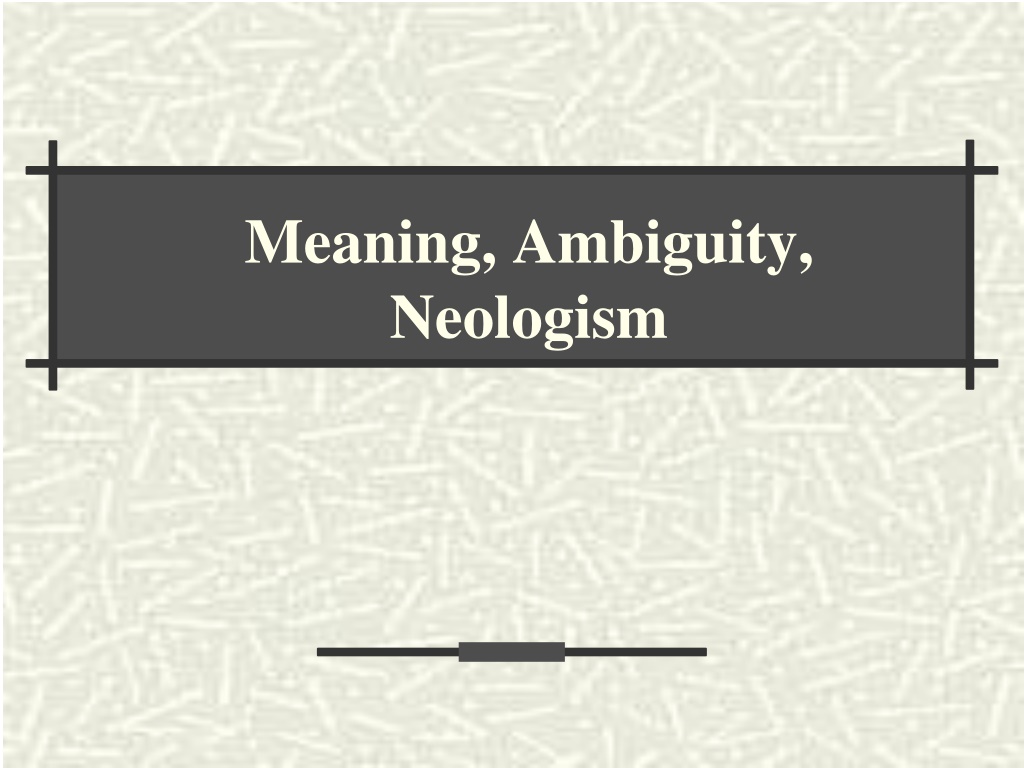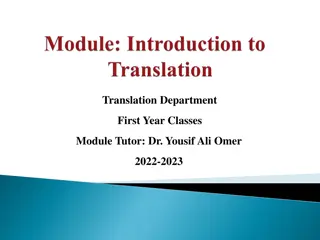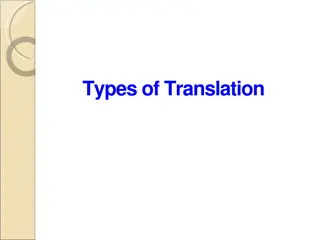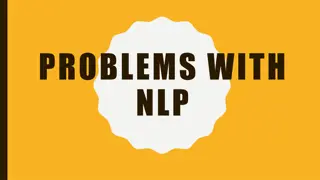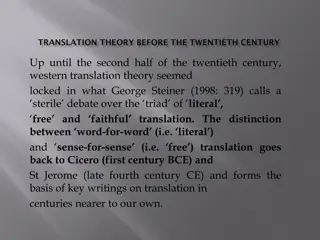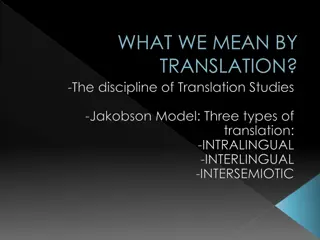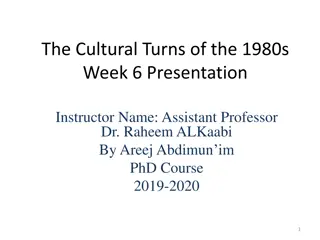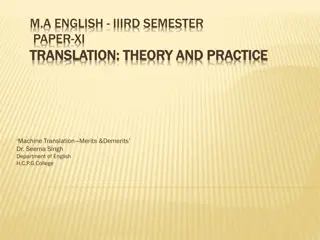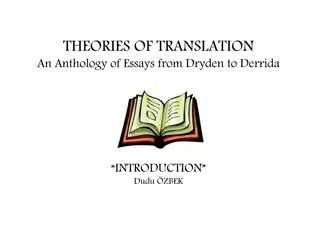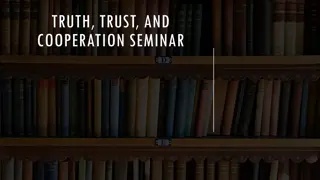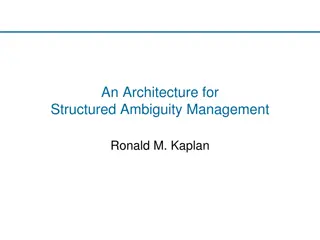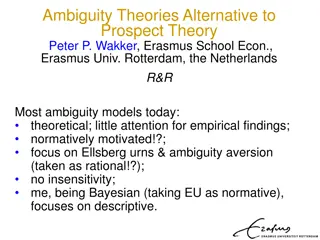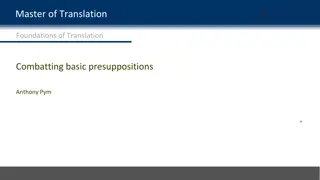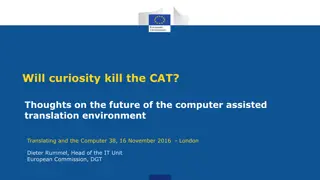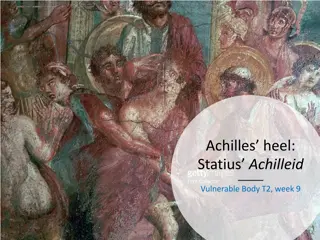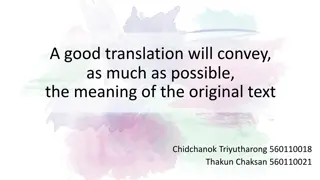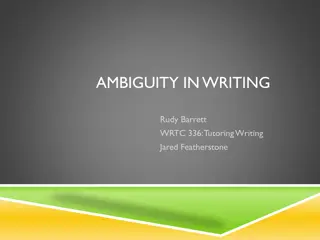Ambiguity in Translation Theory
Exploring the complexities of ambiguity in translation theory, this content delves into the nuances of meaning, neologisms, and the challenges faced by translators in deciphering text. It discusses the various types of ambiguity, such as lexical and semantic, highlighting their impact on language interpretation. Through examples and analysis, it emphasizes the crucial role of translators in navigating the diverse layers of meaning within texts.
Download Presentation

Please find below an Image/Link to download the presentation.
The content on the website is provided AS IS for your information and personal use only. It may not be sold, licensed, or shared on other websites without obtaining consent from the author.If you encounter any issues during the download, it is possible that the publisher has removed the file from their server.
You are allowed to download the files provided on this website for personal or commercial use, subject to the condition that they are used lawfully. All files are the property of their respective owners.
The content on the website is provided AS IS for your information and personal use only. It may not be sold, licensed, or shared on other websites without obtaining consent from the author.
E N D
Presentation Transcript
The Philosophy of Education Meaning, Ambiguity, Neologism
The translation theorist is concerned from start to finish with meaning. He is , however , not concerned with the theoretical problems and solutions of semantics, linguistics, philosophy , but applications in as far as they can help the translator problems. logic with and their only solve his
First whether the whole or a part of the text is straight (means what it says ) , ironical ( slightly or entirely opposite in meaning ) , or nonsensical. , the translator must assess
Secondly , the theorist has to decide which of the countless varieties of general meaning he has to take account of . In my opinion , these are the linguistic, the referential , the subjective , the force or intention of the utterance , the performative , the inferential , the cultural , the code meaning, the connotative pragmatic and the semiotic. , the
In ambiguity ambiguity ambiguity) is the presence of two or more possible meanings within a single sentence words, as opposed ambiguity, which is the presence of two or more possible meanings within a single word English grammar, (also or syntactic structural grammatical called or sequence to of lexical
The chicken is ready to eat I saw the man with glasses Flying planes can be dangerous.
Lexical ambiguity is the subtype of semantic ambiguity occurs at the level of words or morphemes. When ambiguity results from a single word having two senses, it is called polysemy which a lexical
I went to the bank. Financial bank/river bank
However pragmatic ambiguity may be the most difficult of all , in cases of fluctuating customs and attitudes respectively , since the text itself may give little due to the meaning , I take cultural meaning to refer to a SL community s customs, and here the meaning of a meal, a kiss, a gesture , a drink , etc. , may be ambiguous unless the translator has a deep knowledge of the community s social habits, including those relating to class, sex , occupation , region , etc . , instances of cultural and
Pragmatic Ambiguity Pragmatic Ambiguity can be defined as the words which have multiple Pragmatic Ambiguity arises when the meaning of words of a sentence is not specific; it concludes different meanings. There are various sentences in which the proper sense is not understood due to the grammar formation of the sentence; this multi interpretation of the sentence gives rise to ambiguity. interpretations. "do you want a cup of coffee", the given the word is either an informative question or a formal offer to make a cup coffee.
Grammatical meaning is more significant ( the tone or flavour of the text , its primary aspect, is perhaps dictated by its syntax), less precise , more general and sometimes more elusive meaning. It can sometimes be identified at text level ( a comedy , a dialectical argument , a farce , a dialogue , a sonnet , a ballad , a formal agenda , the minutes of a meeting , etc . , viz. the accepted term for a formal paragraph level ( a declaration as thesis , antithesis or synthesis, followed by two or three supporting statements). than lexical utterance) or at
Translation Procedures Transcription transfer) One-to-one translation , Through -translation ( loan- translation ) Lexical synonymy, translation by a close TL equivalent Componential analysis Transposition , the grammatical unit by another Modulation Compensation, Cultural equivalence, ( loan words , adoption , replacement of one
Translation Procedures Translation label, i.e. an approximate equivalent Definition, Paraphrase , an amplification or free rendering of the meaning of translator s last resort, Expansion -grammatical expansion Contraction grammatical reduction Recasting sentences . French complex sentences are sometimes recast as English co-ordinate sentences. Rearrangement, improvements ( jargon , mistakes, misprints , idiolect , clumsy writing, etc.) Translation couplet ,literal translation
Treatments of Neologisms Formal completely Oversharers Derived formed with productive prefixes ( i .e , de- \ mis- , non- , pre- \ ' pro-) and suffixes (e.g , -ism , -ize1, -ization1), e . g . misdefine , non-event , encyclopaedism , taxon, paraclinique , etc. If such neologisms are transparently comprehensible , the translator can cautiously naturalize1 them , assuming that Latin and Greek roots acceptable in the TL particularly in technological texts. new words. Google/
Treatments of Neologisms New collocations , e.g. urban guerrilla1, unsocial hours . Normally it is unwise to attempt a loan or through translation unless the translator is officially authorized to do so , otherwise he has to normalize . Meeting in camera Phrasal ( nouns or verbs ) trade-off , zero in , etc . The translator has to normalize these in the TL usually by translating into two or three words. Acronyms (UN,EU) Blends ( portmanteau words ) -----Smoke + fog = smog -----Breakfast + lunch = brunch -----Spoon + fork = spork
Treatments of Neologisms New unsocial hours . Normally it is unwise to attempt a loan or through translator is officially authorized to do so , otherwise he has to normalize . Phrasal ( nouns or verbs ) trade-off , zero in , etc . The translator has to normalize these in the TL usually by translating into two or three words. Acronyms Blends ( portmanteau words ) -----Smoke + fog = smog -----Breakfast + lunch = brunch collocations , e.g. urban guerrilla1, translation unless the
Treatments of Neologisms Semantic , old words with new meanings, e.g. umbrella , gay . These should be normalized ( i. e. translated by a normal word ). Abbreviations (shortened form of word). These are commoner in French and German than English; e. g. Uni , Philo, Beeb , vibes , bac , Huma\ they are normalized (i.e . translated unabbreviated) , unless there is a recognized equivalent.
what translation theory cannot do It cannot make a bad translator into a good one. It cannot make a student intelligent or sensitive two qualities translator . Translation is an art as well as a skill and a science , and translation theory cannot teach anyone to write well , although it can expose bad writing as effectively as translation itself . of a good
what translation theory can do show the student all that is or may be involved in the translation process (and certainly that is far more than what he is usually aware of ) and to offer principles and guidelines (some of which , like those relating to the translation of institutional terms, are contradictory) considering which , he makes his choices and decisions. , after
what translation theory can do translation theory can stop him making howlers like translating periodical or mistakes translating a layman s term by a technical term . Mainly , the translation theorist is concerned to see that no linguistic or cultural factor is ignored when one is translating. the of title usage of a like
Translation theory and translation methodology Since translation theory is applied to a variety of texts , and concerned with comparing systems, its theorizing function consists of identifying a general or particular problem , enumerating the various options, relating them to the TL text and reader , proposing a solution and then discussing the generality of the problem for future use. is not basically language
Translation theory and translation methodology Certain theoretical problems , such as what constitutes translation variance or invariance , the ideal unit of translation , or even translation accompanied by diagrams and logical symbols , appear to me now to be not very profitable unless they are related to one language function informing a group of text-types. equivalence , the process of
Translation theory and translation methodology Translation methodology making the translator pause and think, with producing a natural text deviation from a natural text or a closest natural equivalent. theory precipitates concerned a with
Translation theory and translation methodology Any talk of a single translation theory , or of one semantic theory for that matter, is a waste of time. Translation theory is eclectic; it draws its material from many sources. Like meaning or translation , it embraces network of relations. a whole
